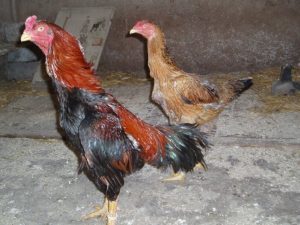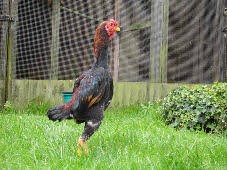Overview
History
The Ko Shamo is an Asian Game Bird Breed and one of the most popular of the seven breeds of Shamo chicken originating from Thailand, but widely kept and intensively bred in Japan for hundreds of years from around the early 1600s Japanese “Edo” period.
All seven breeds of Shamo chicken are National Monuments in Japan and very much seen as a strong part of the national heritage of Japan. There are two groups and 15 breeds of chicken protected by Japanese National Monument legal status of 1941, with the aim of avoiding extinction of these historic birds.
The large Shamo cockerel was bred specifically for cockfighting, which is still legal in Japan and other Asian countries. There was a Japanese custom to eat the Shamo that lost the fight. The name “Shamo“(sometimes used as a general designation for gamebirds in Japan) is believed to be a Japanese corruption of the word “Siam”.
The Kingdom of Siam was the original name for the country now known as Thailand, from where Malay/Asil/Aseel type chickens were sent to Japan for breeding purposes.
Breed Weight & Height
Mature hens will typically weigh around 1.5 pounds (.7 kg) and can be up to 11 inches (28 cms) tall.
Male roosters can weigh up to two pounds (1 kg) and be over 13 inches tall (33 cms).
Why Keep Ko Shamo Chickens?
Ko Shamu are suitable for dual egg and meat production, but are mostly kept by backyard chicken enthusiasts for their striking posture, strutting walk, bold attitude and unique looks.
In the UK & USA it can be quite challenging to find pure bred Ko Shamo chickens for sale, as there are so many cross breeds.
Eggs
Size
Eggs are small in size.
Color
Eggs are usually light brown or white, sometimes with speckles.
Production per year
70 eggs per year
When do they start laying eggs?
From 7 months
Ko Shamo Characteristics
Temperament / Are they good as pets?
The Ko Shamo cockerel can quickly develop a territorial nature and their theatrical aggression can lead to fights with other male birds, but if raised with care will get along fine with humans.
Whilst not as aggressive as the much larger Shamo, the Ko Shamo can still be temperamental. For this reason, it is not recommended to keep more than one male bird.
Ko Shamo hens are considered to be good mothers and generally get along quite well together. One cockerel for around 5 hens is a good ratio.
The Ko Shamo is a wiry, lean and muscular bird, sometimes described as cheeky. If given enough space to roam and not too closely confined the Ko Shamo will do well as an addition to a backyard flock.
The Ko Shamo has sparse plumage, therefore lacking good heat insulating feathers, but they can tolerate fairly cold conditions for short lengths of time, when properly housed and fed. In Japan many years ago Ko Shamo were deliberately bred to be of a small size, suitable for keeping as pets inside wealthy peoples’ homes, as a status symbol.
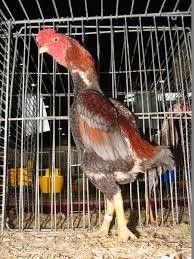
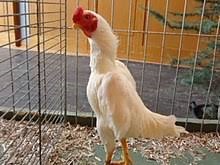
Appearance
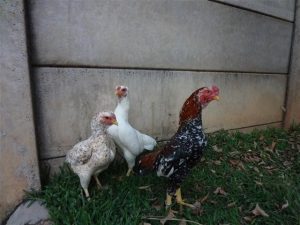
Plumage is quite sparse on the whole body, with short, hard feathers which can vary greatly in color from black, brown, red, blue/green, gray, ginger to white, with a small ‘prawn/shrimp shaped’ tail. The flesh is an unusual red color and this will be on view around the keel area, where plumage is very sparse or non-existent.
Females can be an attractive wheaten colour with slight shades of ginger, and spangled birds with white tips on the feathers are highly sought after for showing. The wings are short and the bird has strong prominent shoulders.
The Ko Shamo has a chrysanthemum combe, prominent brow ridge (beetle brow), a good broad head, short curved yellow beak, the iris is white or yellow and the wattle is small or completely absent. Feet are usually yellow.
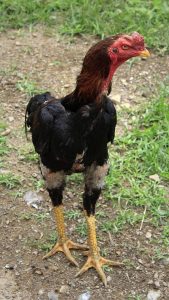
The Ko Shamo (Small Shamo or bantam) is a smaller ornamental breed which is popular due to its unusual, very upright almost vertical stance, making the cockerel appear to be standing on tip-toe and extending his long neck. Described by some Ko Shamo breeders as having “an erect strutting carriage, the look of a prize fighter and confident manner”.
Feeding
What should I feed them?
When you first get your chickens home you should feed them growers mash, as it has a higher percentage of protein (19%) and is refined so that it can be easily ingested.
You should feed them growers mash up until 6 weeks where they should be fed chicken pellets which is just feed in pellet form, this has between 15-16% protein.
At 18 weeks your chickens need more nutrients to help with egg production so slowly start feeding them layers mash or pellets which has around 16% protein.
Chickens will need access to fresh drinking water all day long, they will prefer cool drinking water, no one is quite sure why maybe it’s a prehistoric throwback. As Ko Shamo are small birds it is important to have the feed and water at the proper height for all birds in the pen.
Ideally feed and water should be at back level. If the water is too low down, Ko Shamo may scratch litter into it and the water will go bad quickly.
Your chickens also need grit to help with egg production, so make sure there is always some within easy access for them at all times.
How much should I feed them?
Ko Shamo are small but hungry birds and will eat anywhere between 2.5 oz (70g) and 4.5 oz (127g) a day, but on average breeders feed their chickens 3.5 oz (99g) a day.
Start by feeding them this and then adjust the weight of feed around how much they consume. You can leave the feed in a feeder for them to eat whenever they please or you can give them set meal times.
Ko Shamo love to forage outside for grubs and bugs.
Your chickens also need grit to help with egg production, so make sure there is always some in easy reach for them at all times.
What can’t they eat?
Chocolate and beans are the two main foods that shouldn’t be eaten by chickens. The phytohemagglutinin in beans can lead to fatalities and the theobromine in chocolate can cause heart problems.
Moldy food that has bad bacteria in it should not be fed to chickens as it can make them very unwell. For this reason, it is illegal to feed your chickens leftovers in the UK.
**What do I need to keep Ko Shamo Chickens?**
Best Ko Shamo Chicken Coop – Omlet Eglu Cube
The most essential item you need to keep chickens is a coop! This should ideally be 0.4 m2 or 4 square feet per chicken. Their run needs 25 square feet per chicken. In the coop they should have a perch to sleep on and a laying box for their eggs.
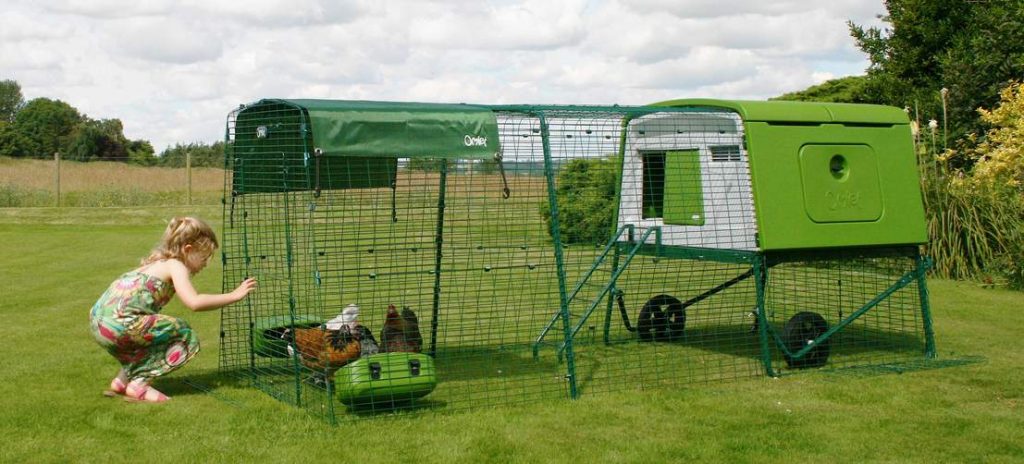
#2 Reasons Ko Shamo’s Love These Coops:
1. Plastic coops are a favorite of all Ko Shamo’s owners and we really recommend the Omlet range because it will keep them warm. Due to their sparse feathering Ko Shamo’s can get cold and sick if exposed to low temperatures. Omlets range is seriously tried and tested on our farm, even when snow is on the ground.

2. The other reason Ko Shamo’s like these coops is because they come with a stand, raising them off the floor. All smaller birds like to roost higher of the floor. Infact pretty much without exception the smaller the bird the higher they like to roost! Ko Shamo’s are no exception and feel much safer up, off the floor in a coop on a stand.
Shop the Omlet Coop range here: www.omlet.us
The Run
These birds are not great flyers and high protective fencing is only necessary to keep predators at bay.
You should invest in a sunken fence to go over and around the coop to keep them safe at night. Find a water bowl which they can’t stand in or push over and place it in the shade, so the water doesn’t get too warm.
Feed and water for Ko Shamo are best placed off the ground, at around the ‘back’ height of the bird. Raised feed and water bowl holders are easily obtained.
They do like space, so either free range them or purchase a large walk-in run for them. Too confined and they will get aggressive and want to fight out of frustration.
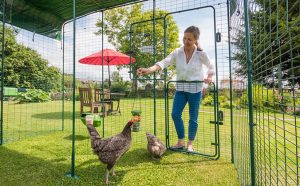
Omlet do the best range of chicken runs that fit with Omlet coops or stand alone. They come recommended as they are made with high strength steel that’s welded rather than twisted together like some traditional chicken wire. Omlet runs are also PVC coated for extra longevity and durability.
Also they come with a unique feature, the ‘anti dig skirt’ which runs around the outside of the run and coop so predators cant tunnel under!
Shop the Omlet Run range here: www.omlet.us
